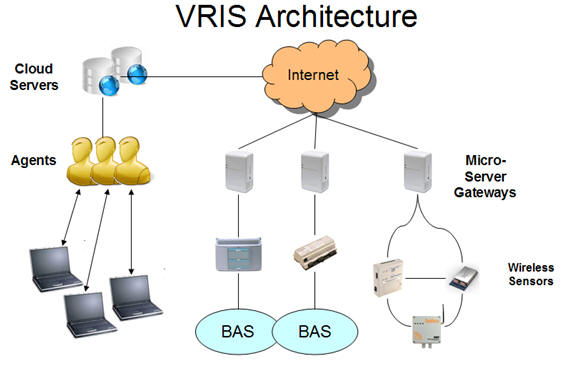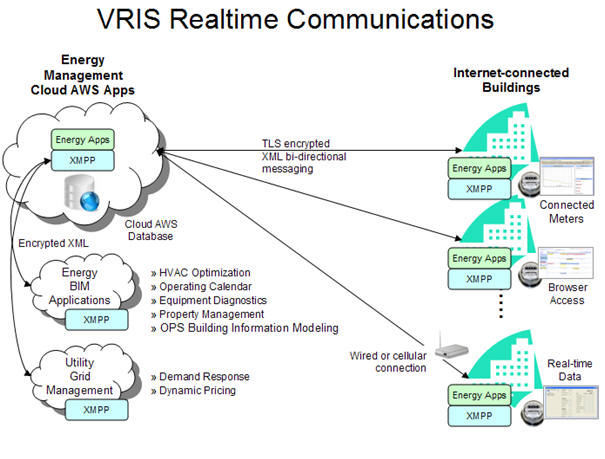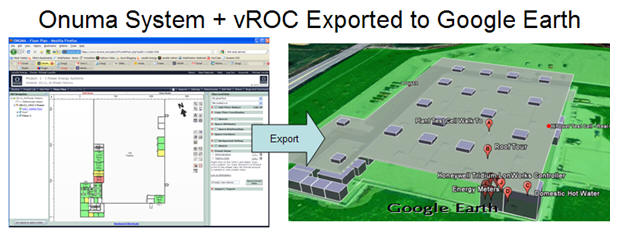May 2010
![]()
AutomatedBuildings.com
[an error occurred while processing this directive]
(Click Message to Learn More)
May 2010 |
[an error occurred while processing this directive] |
|
|
|
Virtual Realtime Information Systems (VRIS) is an application of cloud-computing. Communications is via the Internet between in-building micro-servers and remotely hosted shared servers, supplied and managed by third party virtual server vendors. Cloud-computing simplifies deployment where one to thousands of servers can be enabled in minutes for huge scaling.
|
|
|
|
|
|
|
|
|
|
|
|
|
[an error occurred while processing this directive] |
|
|
|
|
|
|
|
|
|
|
|
|
|
|
|
[an error occurred while processing this directive] |
VRIS leverages the ONUMA System BIMStorm® cloud
computing design processes, making possible realtime multi-discipline building
industry collaboration. VRIS also uses the Virtual Realtime Operating Center (vROC)
developed by Lavelle Energy that connects object data from building sensors and
uses open standards for monitoring and analysis. vROC can run hundreds(+) of
realtime building information feeds to hundreds(+) of users simultaneously.
The ONUMA System + vROC combination, VRIS, is the ultra realtime BIM and energy
management platform. This unprecedented capability to view and manage building
performance lets participants manage thousands of buildings from separate
Internet connections anywhere in the world. VRIS enables Smart Buildings.
VRIS supplements and enhances building systems by providing near-realtime
information about building environment and energy performance. It uses web
browsers and applications like Google Earth, to enable timely access to building
operating data. VRIS is sufficiently robust that key building operating data can
be continuously captured and analyzed using cloud-based applications.

VRIS simplifies the sharing of building performance
information with occupants. It offers the ability to combine HVAC operating data
with energy usage to create measurable data to enable “green leases”. This type
of lease is often used as part of an owner or tenant effort to minimize their
carbon contribution to the global warming. Effective green leases often use
sub-metering to measure energy performance and VRIS can be effectively deployed
in this effort.
It’s a Two-way Street
Collecting data is not enough. An effective VRIS installation also writes data
back to the building automation or temperature control system. By updating key
equipment control algorithms, building energy-consuming equipment can change how
it operates as the day - and seasons - progress. Fixed control transitions to
VRIS dynamic control.
Dynamic control uses cloud-based optimization routines to select better
operating variables. If an air handler delivers constant temperature discharge
air to the space, dynamic control algorithms can analyze widely dispersed space
and HVAC equipment parameters to optimize performance. This type of analysis can
also be done using an in-building computer but with important limitations.
Cloud-based optimization apps offer the ability for a refined analysis instance
to work with hundreds to thousands of buildings – sharing common experiences for
the best results.

Visualizing Building
Operations – See It Now with Realtime BIM
Most of us react to visual data more effectively than a table array of data.
Building automation systems are limited to simple two-dimensional views of floor
plans. Clever designers build two and half dimension (2.5D) images that look
like pseudo room drawings. VRIS, by contrast, offers the first opportunity to
see buildings in 3D using Building Information Modeling. BIM is often considered
only a design tool. In VRIS, however, realtime BIM enables visualization of
physical data in 3D.
BIM is more than 3D. BIM is not only used to describe the building envelope but
also HVAC equipment including equipment properties. A chiller is more than just
a 2D equipment image. In BIM, equipment can be described in terms of physical
characteristics and, very importantly, energy performance characteristics.
What is the current operating performance of a chiller or air handler,
especially as it relates to the building as a whole? Does anyone know today?
Unlikely. This is where VRIS raises the bar of visualizing, understanding, and
characterizing building energy and environmental performance. Do it all better
in BIM. Do it all best in realtime VRIS.

VRIS is Realtime BIM
Combining realtime information with Building Information Modeling provides
significantly more value to building owners and operators. For the first time it
also gives tenants and occupants a chance to participate in minimizing building
energy usage and CO2 footprint. As a practical matter, VRIS supports a variety
of additional services such as realtime data, video feeds, static images, and
access to maintenance and operations programs. The image below shows how Google
Earth views can be combined with realtime information from building sources.
This includes equipment realtime performance, like the VAV box temperature strip
chart, as well as videos of internal building operations and static camera
images. It all fits inside Google Earth. Data information can be limited to
selected users by creating multiple views of a given building – a quick process.

VRIS Features – Nuts and
Bolts
Security: VRIS installations incorporate high
security levels including end-to-end encryption. All data traffic, including
between servers, is fully encrypted.
Backup: Communications loss with cloud servers can
shutdown data retrieval and analysis but not impact alarming and alerting
functions. VRIS applications use in-building micro-servers, as many as
necessary, to create and support fully functional first-level building support.
That is, alarms and alerts are generated and managed by algorithms running at
the building level micro-servers. Separate communication links, such as cellular
and radio, are part of the redundancy features of a successful VRIS
installation.
Scalability: VRIS, by definition, must be able to
deal with near realtime information from not hundreds but thousands of building
simultaneously. This type of scalability requires more than raw computing power.
It requires the ability to minimize bandwidth using simple realtime
publish/subscribe techniques. HTTP is out. XMPP is in.
Smart Grid Participation: Demand Response providers
and utilities now use a variety of communication methods to signal the need for
demand reduction. All of these methods can now be combined into VRIS.
Aggregation: Now buildings can be linked together
as part of an aggregated approach to demand management. Utility and Demand
Response commands can be delivered to buildings in a seamless manner using
in-building micro-servers to implement the commands.
Micro-grids: Building automation systems and local
energy sources, such as solar panels, generators, and battery packs, can work
across traditional boundaries using short messaging packets over the Internet as
part of VRIS.
Operating Information Overview: VRIS can leverage
Google Earth at a high level where placemarks change color to show energy or
operational questions. Click to zoom to the details. View thousands of buildings
in near realtime.
Open Standards: VRIS is based on open standards
entirely. Connections between other communication standards are handled through
protocol converters enabled through a vROC wrapper.
Equipment Documentation: Current methods use PDF
files listed by category or other attribute. VRIS provides a direct connection
between a 3D image of the equipment and all related support documents. Only VRIS
can provide this type of simplicity and visual association.
Drawings: Today’s building drawings are either
printed or in CAD files. Threading through these files takes time because there
is no way to visually associate them with a physical location. VRIS resolves
this problem by creating 3D BIM building images in the ONUMA System and in lieu
of multi-layered CAD drawings.
Tenant Participation: Google Earth files (KMZ) can
be quickly created for a variety of tenants and occupants using VRIS-generated
BIM data. Views of specific spaces can be delivered for restricted access on a
need-to-know basis. More interestingly, Google Earth images can update in near
realtime (dynamic updates) the same as in web-based realtime views with VRIS.
This makes current building information, like energy usage and equipment
efficiency, available to a wide variety of participants. For the first time
realtime building information is presented in two well known and simple to use
applications – web browsers and Google Earth.
[an error occurred while processing this directive]
ONUMA System and BIMStorm®
The ONUMA System is a web-based Building Information Modeling software. Using
the BIMStorm® cloud computing design processes, realtime multi-discipline
building industry collaboration is possible. The ONUMA System promotes open
standards while mashing-up industry knowledge. The building, geo-spatial and
energy industries use the award winning web-based BIMStorm® process for planning
and design because of its strong visual capabilities that resolve complex
relationships and environmental issues.
ONUMA implements BIM as a web browser application. ONUMA BIMStorms are the first
opportunity for hundreds of users to simultaneously participate in building
design using BIM over the web. BIMStorms have been used as collective
collaborations by users around the world – designing buildings for today and the
future in near realtime.
The ONUMA System is involved with building design, master planning and, now,
realtime building information modeling. Realtime BIM is the evolution of
buildings designed in BIM to buildings operating in BIM. This transition is
moves BIM beyond its roots and expands the opportunities to use BIM designs in
daily building operations.
Lavelle Energy and vROC
VRIS leverages vROC for realtime information access. vROC uses XMPP for
communications with protocol wrappers for connection with any realtime
equipment. vROC is fast. No data polling is used. All information is handled
through publish/subscribe methods to keep data traffic at a minimum.
vROC is domain based. Multiple vROC micro-servers in a building interactively
cooperate within their own domain. If one goes down the others automatically
handle that functionality. Further, vROC supports building domains linked to
outside Cloud services for transparent building-to-cloud communications.
vROC installation is simple. Plug the vROC micro-server into the building
network and it immediately creates a connection to the vROC cloud server. No
need for IT setup and no need to create special firewall rules. Reverse
connection from outside the building to the vROC micro-server is instantaneous
to simplify data communications and support. Forget IT hassles.
vROC is secure. All data traffic is encrypted to 256 bit SSL/TLS levels – the
same as banking. This is end-to-end full encryption supported by security
certificates.
Summary
VRIS moves building automation from simple web-based applications to 3D visual
information. It improves data throughout and extends realtime data to multiple
simultaneous users without incurring significant data transmission overhead.
Users looking for the next opportunity in building energy management computing
should consider VRIS as the logical successor to today’s technology.
About the Authors
Michael Lavelle is a principal in Lavelle Energy LLC. He has been working with building automation since the mid 70s when so-called automation ran on 4 bit microprocessors. You can reach him at mike@lavelleenergy.com
Kimon Onuma, FAIA is an architect and a software architect who has been a
leading proponent of open standards to improve productivity and reduce waste in
the building and energy industries. Pasadena, Calif.-based ONUMA, Inc. has won
numerous awards for its significant contributions to multiple professional
associations.
Onuma.com
[an error occurred while processing this directive]
[Click Banner To Learn More]
[Home Page] [The Automator] [About] [Subscribe ] [Contact Us]